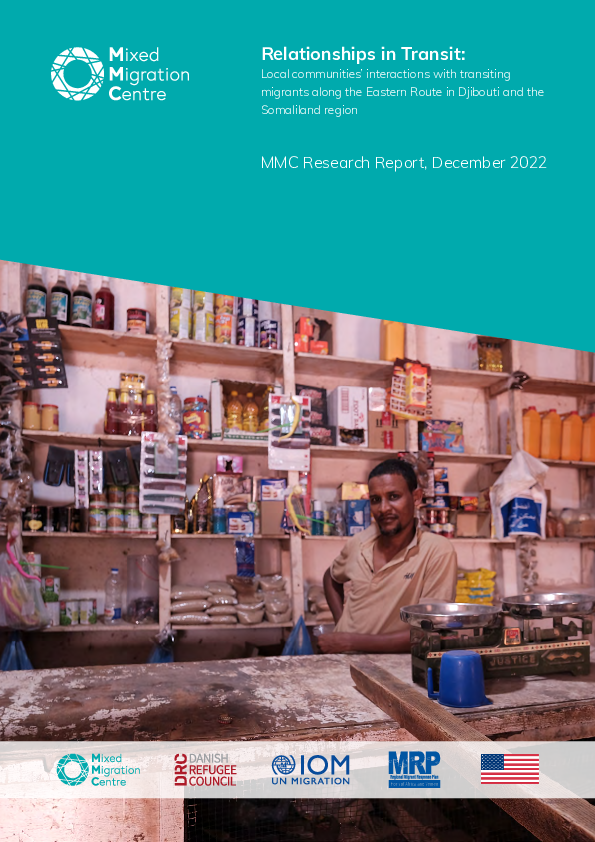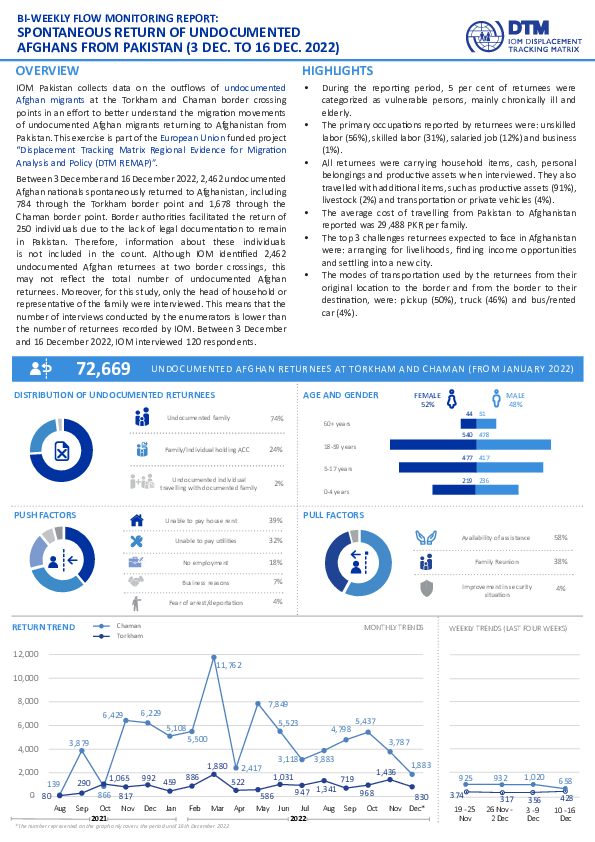-
Countries
-
Data and Analysis
-
Special Focus
-
Crisis Responses
Dec 23 2022
Print
Type
Project factsheet
Published date
Fri, 12/23/2022 - 00:04
Dec 23 2022
Print
Type
Methodological framework
Published date
Fri, 12/23/2022 - 00:04

Contact
RO Dakar, RODakar-DataResearch@iom.int
Language
English
Location
Sierra Leone
Period Covered
Dec 16 2021
Dec 25 2021
Activity
- Other
- Survey
- Community Perception
- Flow Monitoring Survey
- Flow Monitoring
This study explored various cross border phenomena with the objective to understand how the emergence of COVID-19 impacted the cross-border chiefdom communities of Kailahun, Pujehun and Falaba
A quantitative and qualitative methodological approach was employed to carry out this survey. Data collection was carried out in twelve chiefdoms across the three districts, and four chiefdoms per district. The survey targeted cross-border residents and migrants through focus group discussions, direct observation and key informants interviews focusing on local leaders, representative of migrants associations, and local business owners. The mixed methods employed in methodological approaches helped in carefully detailing the different types of consequences of covid-19 on the cross-border communitites.
Like in many other countries affected by COVID-19, this study confirmed that most official points of entry (PoEs) were closed during the border closure proclamation approved by the government (March to July 2020). The regulations instituted by the government severely restricted movements and local by-laws in the various communities became an integral component to the COVID-19 mitigation strategies.
A key factor central to this study was the socioeconomic impacts of COVID-19: the study noted that community inhabitants, including host communities and migrant residents, faced intense socioeconomic disruptions and for many, recovery from it has been slow and partial. Additionally, COVID-19 increased security and protection concerns around vulnerable inhabitants.
The study collected information on both official and unofficial points of entry, and confirmed that mobility inflows and outflows from Sierra Leone to Liberia and from Sierra Leone and Guinea following the re-opening of borders is high. While the occurrence of regular and orderly cross-border movements is vital for peace and stability in communities from the three countries, the presence of a weak border management system and functional infrastructure, as well as appropriate covid-19 management measures could remain challenging to border communities. As a way of mitigating these challenges, a couple of recommendations were highlighted. (1) Increase donor engagement: the three districts, Kailahun, Pujehun and Falaba, lack substantial socioeconomic livelihood supports. One way these locations could overcome the pains imposed by COVID-19 is for an increase donor concentration in these locations with socio-economic livelihood supports. This support needs to be tailored towards trade and agriculture in particular, as they are the major occupation for majority of the inhabitants. This would contribute in easing the extreme livelihood challenges imposed therein by COVID-19. (2) Increase funding for border infrastructure and management: As it is presently, there is a need for a support with new physical border infrastructure (border post) at points of entry in these districts. This would contribute towards cross-border security and substantial control of disease emanating from neighboring countries.
Contact
DTM Somalia Location
Somalia
Activity
- Mobility Tracking
- Event Tracking
Period Covered
Dec 10 2022 -Dec 15 2022
In early 2022, as the drought continued to worsen with displacement increasing in Somalia, DTM team started to pilot an Emergency Trends Tracking (ETT) tool in Gedo region to monitor displacement trends and hotspots in support of operational planning. In July 2022, four failed consecutive rainy seasons have resulted in 90% of the country experiencing severe drought conditions. Considering the extension of the drought, DTM team decided to expand its ETT to Bay region as data providers reported significant displacements from June 2022 in the region. To avoid duplication/maximization of resources, this expansion was done in close coordination with the CCCM Cluster to ensure that the ETT focuses on host community locations and IDP sites that are not covered by the CCCM Cluster’s New Arrivals tracker. This is to avoid duplication and ensure maximization of resources. ETT is a crisis-based tool that tracks sudden displacement triggered by specific events or emerging crises. The objective of ETT is to help prioritize humanitarian response and to enable partners to deliver rapid assistance. Based on previous drought induced displacement patterns, and the ones observed since the beginning of the drought, the humanitarian community expects that people will move from rural to urban areas in search of humanitarian services. Consequently, this ETT tool which concentrates only on drought induced displacements, focuses on the main urban centers and surrounding villages for each district. The data is collected through Key Informant Interviews (KIIs) at the location level, from Sunday to Wednesday every week. All locations assessed are monitored each week. The CCCM Cluster New Arrivals was established in early 2022 in response to the drought to provide weekly updates on new arrivals entering CCCM partner managed IDPs sites. The system allows CCCM partners network staff to report daily or weekly on new arrivals in CCCM partner managed sites.
Population Groups
Survey Methodology
Unit of Analysis Or Observation
Type of Survey or Assessment
Keywords
Geographical Scope
Administrative boundaries with available data
The current dataset covers the following administrative boundaries
Contact
DTM Somalia Location
Somalia
Activity
- Mobility Tracking
- Event Tracking
Period Covered
Dec 03 2022 -Dec 08 2022
In early 2022, as the drought continued to worsen with displacement increasing in Somalia, DTM team started to pilot an Emergency Trends Tracking (ETT) tool in Gedo region to monitor displacement trends and hotspots in support of operational planning. In July 2022, four failed consecutive rainy seasons have resulted in 90% of the country experiencing severe drought conditions. Considering the extension of the drought, DTM team decided to expand its ETT to Bay region as data providers reported significant displacements from June 2022 in the region. To avoid duplication/maximization of resources, this expansion was done in close coordination with the CCCM Cluster to ensure that the ETT focuses on host community locations and IDP sites that are not covered by the CCCM Cluster’s New Arrivals tracker. This is to avoid duplication and ensure maximization of resources. ETT is a crisis-based tool that tracks sudden displacement triggered by specific events or emerging crises. The objective of ETT is to help prioritize humanitarian response and to enable partners to deliver rapid assistance. Based on previous drought induced displacement patterns, and the ones observed since the beginning of the drought, the humanitarian community expects that people will move from rural to urban areas in search of humanitarian services. Consequently, this ETT tool which concentrates only on drought induced displacements, focuses on the main urban centers and surrounding villages for each district. The data is collected through Key Informant Interviews (KIIs) at the location level, from Sunday to Wednesday every week. All locations assessed are monitored each week. The CCCM Cluster New Arrivals was established in early 2022 in response to the drought to provide weekly updates on new arrivals entering CCCM partner managed IDPs sites. The system allows CCCM partners network staff to report daily or weekly on new arrivals in CCCM partner managed sites.
Population Groups
Survey Methodology
Unit of Analysis Or Observation
Type of Survey or Assessment
Keywords
Geographical Scope
Administrative boundaries with available data
The current dataset covers the following administrative boundaries

Contact
dtmhaiti@iom.int
Language
French
Location
Haiti
Period Covered
Nov 19 2022
Nov 25 2022
Activity
- Event Tracking
Une recrudescence des affrontements entre gangs rivaux, ainsi que l'éruption de manifestations parfois violentes, des pillages, pénuries de biens essentiels et le blocage d'axes routiers et ports dans la Zone métropolitaine de Port-au-Prince (ZMPP) au cours des derniers mois ont accrû l'insécurité déjà présente et ont aggravé une situation économique déjà précaire. Cette situation s'est accompagnée, depuis octobre, d'une flambée épidemique de choléra. Tout cela a contribué à des déplacements urbains à grande échelle. Ce rapport présente les résultats de l'évaluation hebdomadaire des déplacements et de la situation humanitaire effectuée par le système d'alerte précoce du ZMPP.
125 nouveaux déplacements (-92% par rapport à la période d'évaluation précédente) et 465 nouvelles arrivées (-82% par rapport à la période d'évaluation précédente) de personnes déplacées internes ont été rapportés pendant la période d’évaluation dans les 336 quartiers évalués. La majorité de ces déplacements ont eu lieu dans la commune de Pétion-Ville (95%). Durant la période d’évaluation du 12 – 18 novembre, la DTM avait observé 1 655 nouveaux déplacements et 2 521 nouvelles arrivées de personnes déplacées dans 332 quartiers évalués.
Malgré les récentes améliorations relatives, la situation sécuritaire reste toujours tendue, avec 40 quartiers affectés par l'insécurité (-29% par rapport à la période d'évaluation précédente) et 36 par des violences généralisées (+13%). 26 quartiers (-10% par rapport à la période d'évaluation précédente) ont signalé une flambée épidémique de choléra dans le contexte de la résurgence des cas de choléra en Haïti, qui au 30 novembre 2022 avait conduit au décès de 237 personnes dans le pays. Quinze quartiers étaient situés à Cité Soleil, les autres étant situés à port-au-Prince (5), Carrefour (3), Delmas (2), et Tabarre (1).

Contact
east-southern-africa@mixedmigration.org
Language
English
Location
Djibouti
Snapshot Date
Dec 22 2022
Activity
- Community Perception
This study, based on a collaboration between the Mixed Migration Centre (MMC) and the International Organization
for Migration (IOM) examines the dynamics between local communities and migrants, most of whom are Ethiopians,
in key transit locations in Djibouti and the Somaliland region, from a local community perspective.

Contact
DTMUkraine@iom.int
Language
Ukrainian
Location
Ukraine
Period Covered
Nov 25 2022
Dec 05 2022
Activity
- Survey
Bійна в Україні, яка розпочалася 24 лютого 2022 року, спричинила безпрецедентну гуманітарну кризу, що охопила всі області країни. У період з 25 листопада по 5 грудня 2022 Міжнародна організація з міграції (MOM) провела одинадцятий раунд репрезентативного експрес оцінювання загального населення України для збору інформації стосовно потоків внутрішнього переміщення та мобільності, а також для оцінювання місцевих потреб. Це оцінювання загального населення слугує первинним джерелом для виявлення сфер із високими гуманітарними потребами та визначення цільових заходів реагування для надання допомоги населенню, що постраждало від війни. Географічне охоплення цього оцінювання покриває всю територію України, усі п’ять макрорегіонів (схід, північ, центр, південь та місто Київ), за винятком Кримського півострова.
Опитування загального населення проведено шляхом набору випадкових телефонних номерів, завдяки чому було анонімно опитано 2 002 унікальних респондентів віком від 18 років із використанням методу автоматизованого телефонного опитування (CATI). Оцінка спирається на дані про населення Фонду народонаселення ООН (UNFPA), які гуманітарна спільнота розглядає як базове значення для чисельності населення в Україні. Особи, які нині перебувають за межами України, під опитування не потрапили. Докладніше про метод і обмеження, у тому числі про визначення МОМ терміну «внутрішньо переміщені особи» для цілей цього оцінювання, див на с. 16. Крім Опитування загального населення, офіційні дані про присутність ВПО на рівні громад в Україні доступні в Матриці відстеження переміщень Базовому оцінюванні (раунд 17, 25 листопада, HDX реєстрація обов’язкова).

Contact
DTM Pakistan, iomisbdtmremapteam@iom.int
Language
English
Location
Pakistan
Period Covered
Dec 03 2022
Dec 16 2022
Activity
- Flow Monitoring
Between 3 December and 16 December 2022, 2,462 undocumented Afghan nationals spontaneously returned to Afghanistan, including 784 through the Torkham border point and 1,678 through the Chaman border point. Border authorities facilitated the return of 250 individuals due to the lack of legal documentation to remain in Pakistan. Therefore, information about these individuals is not included in the count. Although IOM identified 2,462 undocumented Afghan returnees at two border crossings, this may not reflect the total number of undocumented Afghan returnees. Moreover, for this study, only the head of household or representative of the family were interviewed. This means that the number of interviews conducted by the enumerators is lower than the number of returnees recorded by IOM. Between 3 December and 16 December 2022, IOM interviewed 120 respondents.
Dec 21 2022
Print
Type
Other
Published date
Wed, 12/21/2022 - 17:11

